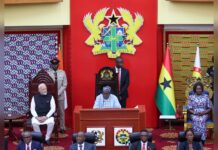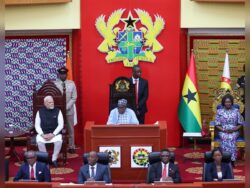By Ernest Bako WUBONTO
The Africa Development Bank (AfDB), in a new report, has highlighted Ghana’s structural shortfalls and funding gap in attaining the Sustainable Development Goals (SDGs) and African Union’s Agenda 2063.
The AfDB stressed that Ghana needs to mobilise US$4.87billion per year until 2030 for the SDGs and US$0.85billion until 2063 for the African Union (UA) 2063 Agenda. However, the country is currently doing only a third of the required amounts, creating a huge deficit that requires stern revenue mobilisation strategies to close up.
The multilateral development finance institution recommended that to bridge this financing gap, Ghana must increase its tax-to-gross domestic product (GDP) ratio by at least 3.8 percentage points for SDGs and by 0.7 for the AU 2023 Agenda.
Furthermore, AfDB stressed the need to allocate more resources to high-need sectors such as education and energy.
“The financial needs for structural transformation in Ghana are huge but within reach. To accelerate its structural change and catch up with the best-performing developing countries.”
With just about five years left to realise the 2030 Sustainable Development Goals (SDGs) agenda, lack of funding to support participation has become the greatest challenge to Ghana’s progress in advancing and meeting the set targets. The inability to mobilise revenue and bridge the funding gap means more people will continue to live in impoverished conditions even after the 2030 deadline.
Reforms needed to strengthen macroeconomic stability
Accessing the country’s macroeconomic stability, the AfDB mentioned that Ghana must pursue reforms aimed at strengthening macroeconomic stability and supporting structural transformation efforts. It underscored the need for monetary, budgetary and exchange rate policies to target inflation control downward as well as reduce pressure on the local currency.
“On the one hand, monetary, budgetary and exchange rate policies must be oriented to further control inflation by bringing it back toward its target, reduce pressure on exchange rates (more stability), reduce the public deficit by rationalising public spending (reduce non-productive expenditure) and mobilising more internal resources, and stimulating inclusive and sustainable growth.
“On the other hand, key reforms should include improving the coordination and sequencing of public sector development initiatives in line with the country’s fiscal position,” the AfDB stressed.
It also urged government to fast-track the ongoing debt restructuring, enhance the scope for concessional finance and deepen financial markets to increase access to affordable credit; and strengthen stakeholder engagement and coordination of development assistance to maximise synergies.
Weak structural transformation
Over the past three decades Ghana has experienced sustainable economic growth, but this growth has been associated with weak structural transformation and has recently become unstable.
Ghana moved from low-income to lower middle-income country status in 2010, thanks to oil production and sound, stable policies.
The post-COVID-19 economic recovery was weak, with real GDP growth moderating to 3.8 percent in 2022 from 5.1 percent in 2021, and estimated at 2.9 percent in 2023 primarily due to macroeconomic instability, tightening global financial conditions and the spillover effects of multiple shocks.
These shocks led to a sharp depreciation of the cedi and a debt crisis in December 2022. Without stern pragmatic measures to ensure meaningful structural transformation, economic growth even when experienced will be unsustainable in the face of internal and external shocks.










